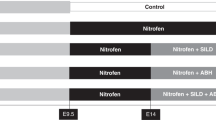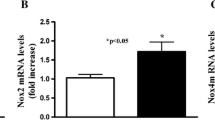Abstract
Purpose
Congenital diaphragmatic hernia (CDH) is associated with pulmonary hypertension which is often difficult to manage, and a significant cause of morbidity and mortality. In this study, we have used a rabbit model of CDH to evaluate the effects of BAY 60-2770 on the in vitro reactivity of left pulmonary artery.
Methods
CDH was performed in New Zealand rabbit fetuses (n = 10 per group) and compared to controls. Measurements of body, total and left lung weights (BW, TLW, LLW) were done. Pulmonary artery rings were pre-contracted with phenylephrine (10 μM), after which cumulative concentration–response curves to glyceryl trinitrate (GTN; NO donor), tadalafil (PDE5 inhibitor) and BAY 60-2770 (sGC activator) were obtained as well as the levels of NO (NO3/NO2).
Results
LLW, TLW and LBR were decreased in CDH (p < 0.05). In left pulmonary artery, the potency (pEC50) for GTN was markedly lower in CDH (8.25 ± 0.02 versus 9.27 ± 0.03; p < 0.01). In contrast, the potency for BAY 60-2770 was markedly greater in CDH (11.7 ± 0.03 versus 10.5 ± 0.06; p < 0.01). The NO2/NO3 levels were 62 % higher in CDH (p < 0.05).
Conclusion
BAY 60-2770 exhibits a greater potency to relax the pulmonary artery in CDH, indicating a potential use for pulmonary hypertension in this disease.



Similar content being viewed by others
References
Hedrick HL (2010) Management of prenatally diagnosed congenital diaphragmatic hernia. Semin Fetal Neonatal Med 15:21–27. doi:10.1016/j.siny.2009.07.012
van den Hout L, Schaible T, Cohen-Overbeek TE et al (2011) Actual outcome in infants with congenital diaphragmatic hernia: the role of a standardized postnatal treatment protocol. Fetal Diagn Ther 29:55–63. doi:10.1159/000322694
Tracy ET, Mears SE, Smith PB et al (2010) Protocolized approach to the management of congenital diaphragmatic hernia: benefits of reducing variability in care. J Pediatr Surg 45:1343–1348. doi:10.1016/j.jpedsurg.2010.02.104
Levin DL (1978) Morphologic analysis of the pulmonary vascular bed in congenital left-sided diaphragmatic hernia. J Pediatr 92:805–809
Shochat SJ, Naeye RL, Ford WD et al (1979) Congenital diaphragmatic hernia. New concept in management. Ann Surg 190:332–341
Noori S, Friedlich P, Wong P et al (2007) Cardiovascular effects of sildenafil in neonates and infants with congenital diaphragmatic hernia and pulmonary hypertension. Neonatology 91:92–100. doi:10.1159/000097125
Koesling D, Friebe A (1999) Soluble guanylyl cyclase: structure and regulation. Rev Physiol Biochem Pharmacol 135:41–65. doi:10.1007/BFb0033669
Stasch JP, Hobbs AJ (2009) NO-independent, haem-dependent soluble guanylate cyclase stimulators. Handb Exp Pharmacol 191:277–308. doi:10.1007/978-3-540-68964-5_13
Evgenov OV, Pacher P, Schmidt PM et al (2006) NO-independent stimulators and activators of soluble guanylate cyclase: discovery and therapeutic potential. Nat Rev Drug Discov 5:755–768. doi:10.1038/nrd2038
Stasch JP, Becker EM, Alonso-Alija C et al (2001) NO-independent regulatory site on soluble guanylate cyclase. Nature 410:212–215. doi:10.1038/35065611
Priviero FB, Baracat JS, Teixeira CE et al (2005) Mechanisms underlying relaxation of rabbit aorta by BAY 41-2272, a nitric oxide-independent soluble guanylate cyclase activator. Clin Exp Pharmacol Physiol 32:728–734. doi:10.1111/j.1440-1681.2005.04262.x
Cau SB, Dias-Junior CA, Montenegro MF et al (2008) Dose-dependent beneficial hemodynamic effects of BAY 41-2272 in a canine model of acute pulmonary thromboembolism. Eur J Pharmacol 58:132–137. doi:10.1016/j.ejphar.2007.11.030
Stasch JP, Evgenov OV (2013) Soluble guanylate cyclase stimulators in pulmonary hypertension. Handb Exp Pharmacol 218:279–313. doi:10.1007/978-3-642-38664-0_12
Stasch JP, Schmidt PM, Nedvetsky PI et al (2006) Targeting the heme-oxidized nitric oxide receptor for selective vasodilatation of diseased blood vessels. J Clin Invest 116:2552–2561. doi:10.1172/JCI28371
Dumitrascu R, Weissmann N, Ghofrani HA et al (2006) Activation of soluble guanylate cyclase reverses experimental pulmonary hypertension and vascular remodeling. Circulation 113:286–295. doi:10.1161/CIRCULATIONAHA.105.581405
Chester M, Tourneux P, Seedorf G et al (2009) Cinaciguat, a soluble guanylate cyclase activator, causes potent and sustained pulmonary vasodilation in the ovine fetus. Am J Physiol Lung Cell Mol Physiol 297:L318–L325. doi:10.1152/ajplung.00062.2009
Pankey EA, Bhartiya M, Badejo AM Jr et al (2011) Pulmonary and systemic vasodilator responses to the soluble guanylyl cyclase activator, BAY 60-2770, are not dependent on endogenous nitric oxide or reduced heme. Am J Physiol Heart Circ Physiol 300:H792–H802. doi:10.1152/ajpheart.00953.2010
Fauza DO, Tannuri U, Ayoub AA et al (1994) Surgically produced congenital diaphragmatic hernia in fetal rabbits. J Pediatr Surg 29:882–886
Schmidt AF, Rojas-Moscoso JA, Gonçalves FL et al (2013) Increased contractility and impaired relaxation of the left pulmonary artery in a rabbit model of congenital diaphragmatic hernia. Pediatr Surg Int 29:489–494. doi:10.1007/s00383-012-3238-8
Tracy ET, Mears SE, Smith PB et al (2010) Protocolized approach to the management of congenital diaphragmatic hernia: benefits of reducing variability in care. J Pediatr Surg 45:1343–1348. doi:10.1016/j.jpedsurg.2010.02.104
Cortes RA, Keller RL, Townsend T et al (2005) Survival of severe congenital diaphragmatic hernia has morbid consequences. J Pediatr Surg 40:36–45. doi:10.1016/j.jpedsurg.2004.09.037
The Neonatal Inhaled Nitric Oxide Study Group (1997) Inhaled nitric oxide in full-term and nearly full-term infants with hypoxic respiratory failure. N Engl J Med 336:597–604. doi:10.1056/NEJM19970227336090
The Neonatal Inhaled Nitric Oxide Study Group (1997) Inhaled nitric oxide and hypoxic respiratory failure in infants with congenital diaphragmatic hernia. Pediatrics 99:838–845. doi:10.1542/peds.99.6.838
Goldman AP, Tasker RC, Hosiasson S et al (1997) Early response to inhaled nitric oxide and its relationship to outcome in children with severe hypoxemic respiratory failure. Chest 112:752–758. doi:10.1378/chest.112.3.752
Mendes-Silverio CB, Leiria LO, Morganti RP et al (2012) Activation of haem-oxidized soluble guanylyl cyclase with BAY 60-2770 in human platelets lead to overstimulation of the cyclic GMP signaling pathway. PLoS One 7:e47223. doi:10.1371/journal.pone.0047223
Jones AW, Durante WJ, Korthuis RJ (2010) Heme oxygenase-1 deficiency leads to alteration of soluble guanylate cyclase redox regulation. J Pharmacol Exp Ther 335:85–91. doi:10.1124/jpet.110.169755
van Loenhout RB, Tibboel D, Post M et al (2009) Congenital diaphragmatic hernia: comparison of animal models and relevance to the human situation. Neonatology 96:137–149. doi:10.1159/000209850
Wang PG, Xian M, Tang X et al (2002) Nitric oxide donors: chemical activities and biological applications. Chem Rev 102:1091–1134. doi:10.1021/cr000040l
Luong C, Rey-Perra J, Vadivel A et al (2011) Antenatal sildenafil treatment attenuates pulmonary hypertension in experimental congenital diaphragmatic hernia. Circulation 123:2120–2131. doi:10.1161/CIRCULATIONAHA.108.845909
Aktan F (2004) iNOS-mediated nitric oxide production and its regulation. Life Sci 75:639–653. doi:10.1016/j.lfs.2003.10.042
Paravicini TM, Touyz RM et al (2008) NADPH oxidases, reactive oxygen species, and hypertension: clinical implications and therapeutic possibilities. Diabetes Care 31:S170–S180. doi:10.2337/dc08-s247
Sayed N, Baskaran P, Ma X et al (2007) Desensitization of soluble guanylyl cyclase, the NO receptor, by S-nitrosylation. Proc Natl Acad Sci USA 104:12312–12317. doi:10.1073/pnas.0703944104
Acknowledgments
Grant #471496/2011-1- the National Council for Scientific and Technological Development (CNPq).
Author information
Authors and Affiliations
Corresponding author
Rights and permissions
About this article
Cite this article
Rojas-Moscoso, J.A., Antunes, E., Figueira, R.R. et al. The soluble guanylyl cyclase activator BAY 60-2770 potently relaxes the pulmonary artery on congenital diaphragmatic hernia rabbit model. Pediatr Surg Int 30, 1031–1036 (2014). https://doi.org/10.1007/s00383-014-3561-3
Accepted:
Published:
Issue Date:
DOI: https://doi.org/10.1007/s00383-014-3561-3




